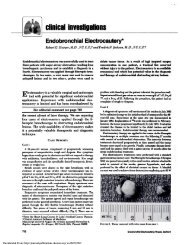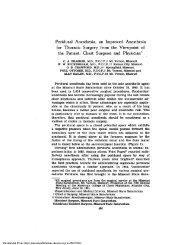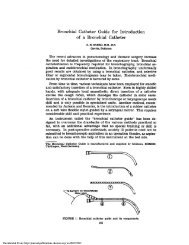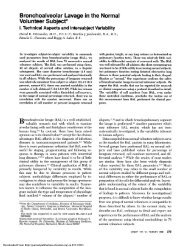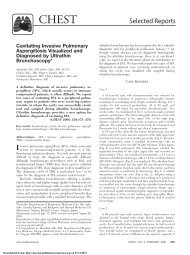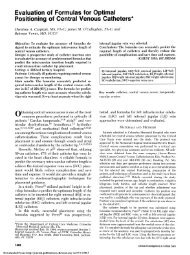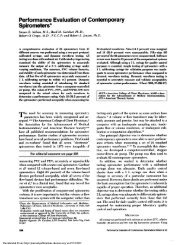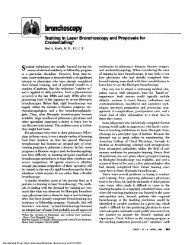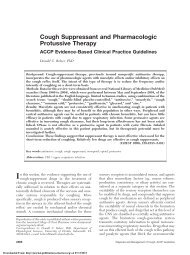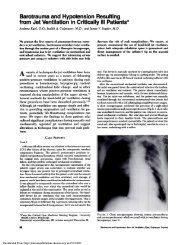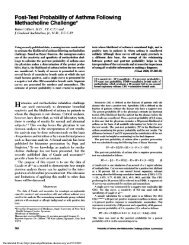Detection of Epidermal Growth Factor Receptor Mutation in ...
Detection of Epidermal Growth Factor Receptor Mutation in ...
Detection of Epidermal Growth Factor Receptor Mutation in ...
Create successful ePaper yourself
Turn your PDF publications into a flip-book with our unique Google optimized e-Paper software.
dermal growth factor receptor (EGFR), and have<br />
recently been used to treat advanced NSCLC. 1<br />
These agents are dramatically effective <strong>in</strong> some<br />
For editorial comment see page 1619<br />
patients yet completely <strong>in</strong>effective <strong>in</strong> others. The<br />
response rate to gefit<strong>in</strong>ib is high among <strong>in</strong>dividuals<br />
with an Asian background. 2<br />
In May and June <strong>of</strong> 2004, two <strong>in</strong>dependent groups<br />
reported an association between somatic EGFR mutations<br />
and a dramatic cl<strong>in</strong>ical response to gefit<strong>in</strong>ib,<br />
respectively. 3,4 Thereafter, EGFR mutations were<br />
extensively <strong>in</strong>vestigated. 5–17 The mutations consist <strong>of</strong><br />
small, <strong>in</strong>-frame deletions or substitutions clustered<br />
around the adenos<strong>in</strong>e triphosphate-b<strong>in</strong>d<strong>in</strong>g site <strong>in</strong><br />
exons 18, 19, and 21 <strong>of</strong> the EGFR gene, and<br />
approximately 90% <strong>of</strong> patients with EGFR mutations<br />
have one <strong>of</strong> two major mutations. One is a 15-base<br />
pair nucleotide <strong>in</strong>-frame deletion (E746 A750del)<br />
<strong>in</strong> exon 19, and the other is a po<strong>in</strong>t mutation<br />
<strong>in</strong>volv<strong>in</strong>g the replacement <strong>of</strong> leuc<strong>in</strong>e with arg<strong>in</strong><strong>in</strong>e at<br />
codon 858 (L858R) <strong>in</strong> exon 21. 18 The above studies<br />
<strong>in</strong>cluded genetic analyses <strong>of</strong> surgical tissues or biopsy<br />
specimens. However, to obta<strong>in</strong> sufficient amounts <strong>of</strong><br />
tumor samples from <strong>in</strong>operable NSCLC patients is<br />
<strong>of</strong>ten difficult. Some studies 19,20 <strong>of</strong> patients with<br />
advanced NSCLC have found a correlation between<br />
cl<strong>in</strong>ical manifestations and EGFR mutation status<br />
obta<strong>in</strong>ed from small tumor samples, such as those<br />
obta<strong>in</strong>ed us<strong>in</strong>g standard transbronchial lung biopsy<br />
(TBLB). All <strong>of</strong> the above studies are limited by the<br />
fact that the rate <strong>of</strong> usable samples obta<strong>in</strong>ed from<br />
enrolled patients is very low. Therefore, a method is<br />
required to detect mutant EGFR, especially the two<br />
major mutations, us<strong>in</strong>g samples other than surgical<br />
tissues from NSCLC patients. We addressed this<br />
problem us<strong>in</strong>g a sensitive technique for actual tumor<br />
sampl<strong>in</strong>g, and a highly sensitive assay for detect<strong>in</strong>g<br />
EGFR mutations.<br />
Pulmonary lesions are most <strong>of</strong>ten cl<strong>in</strong>ically diagnosed<br />
us<strong>in</strong>g flexible bronchoscopy. Common bronchoscopic<br />
sampl<strong>in</strong>g techniques used for pulmonary<br />
lesions are transbronchial needle aspiration (TBNA)<br />
and TBLB. One report has <strong>in</strong>dicated that TBNA is<br />
superior to TBLB <strong>in</strong> diagnos<strong>in</strong>g pulmonary lesions:<br />
Gaspar<strong>in</strong>i et al 21 found that the diagnostic sensitivity<br />
<strong>of</strong> these techniques is 50.0% for TBLB, 70.1% for<br />
TBNA, and 76.0% for TBLB and TBNA together.<br />
We thus presumed that TBNA is a highly sensitive<br />
means <strong>of</strong> tumor sampl<strong>in</strong>g, and that DNA obta<strong>in</strong>ed<br />
from such specimens might provide useful <strong>in</strong>formation<br />
about the mutation status <strong>of</strong> the EGFR gene.<br />
We postulated that Scorpions Amplified Refractory<br />
<strong>Mutation</strong> System (ARMS) [DxS; Manchester,<br />
UK] technology would enhance the sensitivity <strong>of</strong><br />
detect<strong>in</strong>g EGFR mutations. Scorpion primers are<br />
used with a fluorescence-based method that specifically<br />
detects polymerase cha<strong>in</strong> reaction (PCR) products.<br />
22 A “scorpion” consists <strong>of</strong> a specific probe<br />
sequence held <strong>in</strong> a hairp<strong>in</strong> loop configuration by<br />
complementary stem sequences on the 5� and 3�<br />
ends <strong>of</strong> the probe. A scorpion can be comb<strong>in</strong>ed with<br />
ARMS to enable the detection <strong>of</strong> s<strong>in</strong>gle-base mutations.<br />
22,23 The ARMS method is used for allele<br />
discrim<strong>in</strong>ation, and additional mismatches have been<br />
<strong>in</strong>troduced near the 3� term<strong>in</strong>i <strong>of</strong> the primers to<br />
enhance specificity. The ARMS method is superior<br />
to both direct sequenc<strong>in</strong>g and the WAVE method<br />
(Transgenomic; Omaha, NE) for detect<strong>in</strong>g EGFR<br />
mutations. 24 Here, we aimed to detect major EGFR<br />
mutations <strong>in</strong> TBNA specimens and to verify the<br />
sensitivity <strong>of</strong> these methods for detect<strong>in</strong>g EGFR<br />
mutations.<br />
Patients<br />
Materials and Methods<br />
We studied patients with NSCLC diagnosed us<strong>in</strong>g specimens<br />
obta<strong>in</strong>ed by TBLB and/or TBNA. Tumors <strong>in</strong> sal<strong>in</strong>e solution were<br />
not collected from enlarged lymph nodes only. After obta<strong>in</strong><strong>in</strong>g<br />
written <strong>in</strong>formed consent from the patients to participate <strong>in</strong> all<br />
study protocols approved by the Institutional Review Board <strong>of</strong><br />
the Cancer Institute Hospital, tumor tissues, tumors <strong>in</strong> sal<strong>in</strong>e<br />
solution obta<strong>in</strong>ed us<strong>in</strong>g TBNA, and cl<strong>in</strong>ical data were collected.<br />
We recorded age at diagnosis, gender, cytologic diagnosis <strong>of</strong><br />
NSCLC, cl<strong>in</strong>ical stage, and smok<strong>in</strong>g status. Cytologic diagnoses<br />
were based on the World Health Organization pathology classification.<br />
Cl<strong>in</strong>icopathologic stag<strong>in</strong>g was determ<strong>in</strong>ed accord<strong>in</strong>g to<br />
the International Union Aga<strong>in</strong>st Cancer TNM classification <strong>of</strong><br />
malignant tumors. Nonsmokers were def<strong>in</strong>ed as those who had<br />
smoked � 100 cigarettes <strong>in</strong> their lifetime. We obta<strong>in</strong>ed detailed<br />
<strong>in</strong>formation about smok<strong>in</strong>g history, <strong>in</strong>clud<strong>in</strong>g age at first cigarette,<br />
packs per day, and number <strong>of</strong> smok<strong>in</strong>g and smoke-free<br />
years (after quitt<strong>in</strong>g). Patients were categorized as follows: never<br />
smoked (� 100 lifetime cigarettes), former smokers (quit � 1<br />
year ago), or current smokers (quit � 1 year ago).<br />
TBNA Sampl<strong>in</strong>g<br />
Four experienced operators performed standard flexible bronchoscopy<br />
(Olympus P260F; Olympus; Tokyo, Japan) us<strong>in</strong>g 21gauge<br />
cytology needles and aspirated for 10 s <strong>in</strong> the standard<br />
fashion. 25 Paired samples consisted <strong>of</strong> two aspirates that were<br />
obta<strong>in</strong>ed <strong>in</strong> immediate succession <strong>in</strong> an identical manner, with<br />
the needle <strong>in</strong>sertion po<strong>in</strong>ts ideally 1 mm apart. At least four<br />
aspirates (two pairs) were obta<strong>in</strong>ed from each site. For cytologic<br />
analysis, the aspirate was immediately placed onto a glass slide,<br />
covered with a second slide, and the slides were drawn apart<br />
under cont<strong>in</strong>uous gentle pressure. The smear was spray-fixed<br />
us<strong>in</strong>g ethanol, processed rout<strong>in</strong>ely and visualized by Papanicolaou<br />
sta<strong>in</strong><strong>in</strong>g. The second aspirate was mixed <strong>in</strong>to 2 mL <strong>of</strong> sal<strong>in</strong>e<br />
solution and stored at – 80°C until DNA extraction.<br />
DNA Extraction<br />
Samples obta<strong>in</strong>ed by TBNA <strong>in</strong> sal<strong>in</strong>e solution were digested<br />
with prote<strong>in</strong>ase K, and then DNA was extracted with phenol-<br />
www.chestjournal.org CHEST / 131 /6/JUNE, 2007 1629<br />
Downloaded From: http://journal.publications.chestnet.org/ on 12/05/2012



